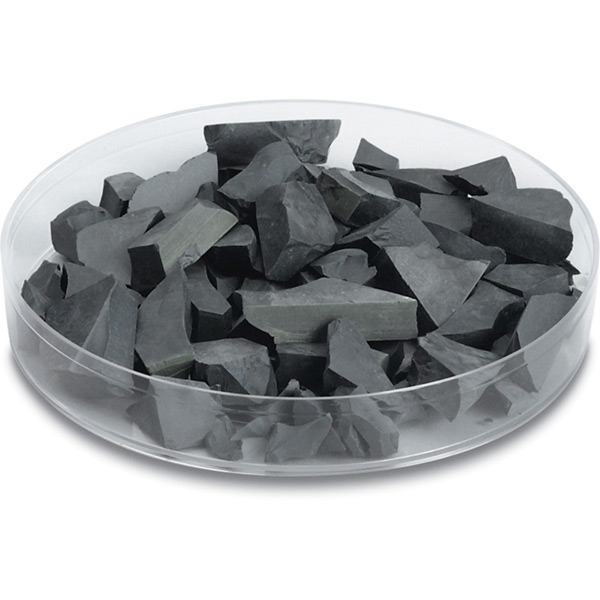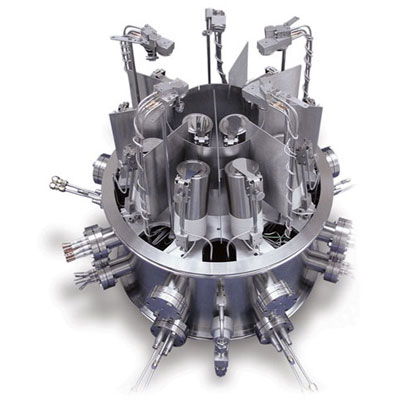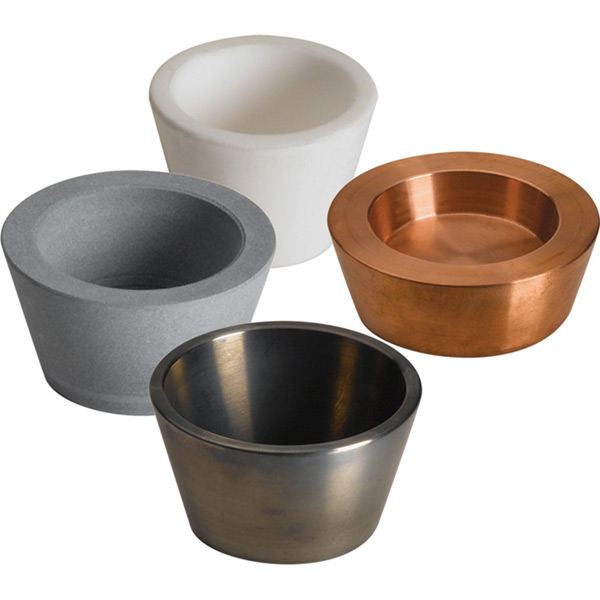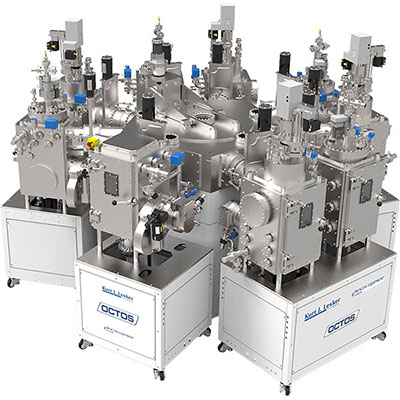Indium Tin Oxide (In2O3/SnO2 90/10 wt %) Pieces Overview
We sell these pellets and pieces by unit weight for evaporation use in deposition processes. These approximate materials prices are published to provide budgetary guidelines. Actual prices can vary and may be higher or lower, as determined by availability and market fluctuations. To speak to someone directly about current pricing, please click here .
Indium Tin Oxide (In2O3/SnO2 90/10 wt %) General Information
Indium Oxide/Tin Oxide (In2O3/SnO2 90/10 WT%) is among one of the most heavily utilized compounds in the thin film industry due to its electrical conductivity and optical transparency. Specifically, the 90/10 WT% composition has a melting point of approximately 1,800°C and a density of 7.14 g/cc. The color of various ITO compounds range from pale yellow to dark green or dark grey. It is evaporated or sputtered under vacuum to generate transparent conductive layers in the manufacture of LCDs and various optical coatings. Thin films of ITO are created for the development of sensors, as well as, a glass coating for the automotive industry.
Indium Tin Oxide (In2O3/SnO2 90/10 wt %) Specifications
| Material Type | Indium Tin Oxide |
| Symbol | In2O3/SnO2 90/10 wt % |
| Melting Point (°C) | 1,800 |
| Theoretical Density (g/cc) | 7.14 |
| E-Beam Crucible Liner Material | FABMATE®, Graphite |
| Suggested QCM Crystal | Alloy Crystal: 750-1002-G10**** |
**** Suggestion based on previous experience but could vary by process. Contact local KJLC Sales Manager for further information
Empirical Determination of Z-Factor
Unfortunately, Z Factor and Shear Modulus are not readily available for many materials. In this case, the Z-Factor can also be determined empirically using the following method:
- Deposit material until Crystal Life is near 50%, or near the end of life, whichever is sooner.
- Place a new substrate adjacent to the used quartz sensor.
- Set QCM Density to the calibrated value; Tooling to 100%
- Zero thickness
- Deposit approximately 1000 to 5000 A of material on the substrate.
- Use a profilometer or interferometer to measure the actual substrate film thickness.
- Adjust the Z Factor of the instrument until the correct thickness reading is shown.
Another alternative is to change crystals frequently and ignore the error. The graph below shows the % Error in Rate/Thickness from using the wrong Z Factor. For a crystal with 90% life, the error is negligible for even large errors in the programmed versus actual Z Factor.

Thermal Evaporation of Indium Tin Oxide (In2O3/SnO2 90/10 wt %)
Thermal evaporation is possible, but difficult for ITO. Controlling the stoichiometry is much more challenging when using thermal evaporation because the indium oxide and tin oxide will evaporate per their individual vapor pressures. For this reason, sputtering is the preferred method of depositing thin films of ITO. Sputtering delivers more successful results in terms of consistency and repeatability.
It is important to note that optical and electrical properties are highly dependent on deposition parameters. We recommend an evaporation temperature of ~600°C and partial pressure of O2 at ~5 X 10-5 Torr. Under these parameters, deposition will occur at a rate of 2 angstroms per second. Post deposition baking at 300-500°C in air oxidizes residual metal components and improves film conductivity. Low sheet resistance is balanced against high transmission in the visible region.
We do not have a specific thermal evaporation source recommendation for ITO. Indium oxide and tin oxide are both compatible with tungsten boats such as our EVS20A015W. Another option would be an aluminum oxide crucible with a tungsten basket heater such as our EVB8B3030W and EVC9AO.
The third option is to use a shielded, tantalum crucible heater with an alumina crucible such as our EVCH10 with EVC9AO if using a KJLC® system. Great care must be taken when installing the heater to prevent the outer shields from becoming warped which can cause a short in the heater, causing the welded joints to fail. The heater should be centered between the contacts and the outer shielding must be clear of the leads. Crucibles should be stored in a cool, dry place and always handled with gloves or forceps.
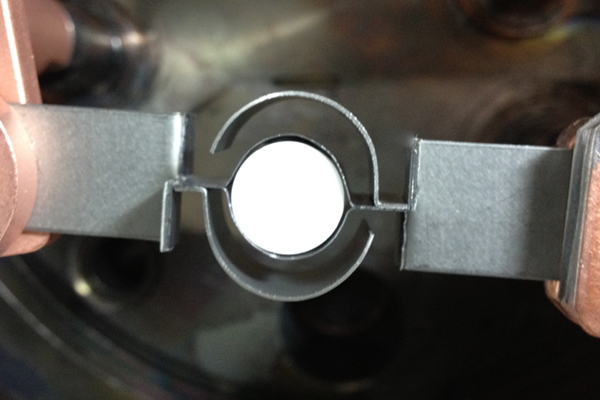
Correct - Crucible heater centered, outer shielding clear of leads
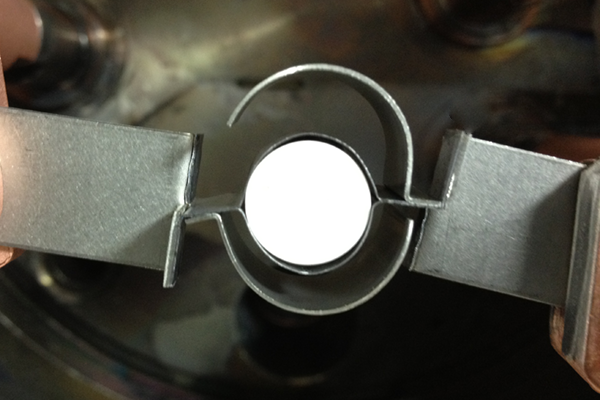
Incorrect - Crucible heater off-center, shielding in contact with leads/inner shielding
E-beam Evaporation of Indium Tin Oxide (In2O3/SnO2 90/10 wt %)
ITO can be deposited by reactive e-beam evaporation. However, as with thermal evaporation, sputtering is the preferred method for ITO deposition. Controlling the stoichiometry is much more challenging when using e-beam evaporation because the indium oxide and tin oxide will evaporate per their individual vapor pressures. Sputtering delivers more successful results in terms of consistency and repeatability. There have been hundreds of papers published over the past few decades on the subject of ITO thin film deposition.
We recommend sweeping the e-beam at low power to uniformly fuse the surface of the pieces and monitoring the pressure to ensure outgassing is at an acceptable level before increasing the power. By sweeping the beam, hole drilling can be avoided. It is important to note that optical and electrical properties are highly dependent on deposition parameters. We recommend an evaporation temperature of ~600°C and a partial pressure of O2 at ~5 X 10-5 Torr. Under these parameters, deposition will occur at a rate of 2 angstroms per second. Post deposition baking at 300-500°C in air oxidizes residual metal components and improves film conductivity. Low sheet resistance is balanced against high transmission in the visible region.
We recommend using either a FABMATE® or graphite crucible liner for e-beam evaporating ITO. A key process note is to consider the fill volume in the e-beam application because we find that the melt level of a material in a crucible directly affects the success of the crucible liner. Overfilling the crucible will cause the material to spill over and create an electrical short between the liner and the hearth. The outcome is cracking in the crucible. This is the most common cause of crucible liner failure. Placing too little material in the crucible or allowing the melt level to get too low can be detrimental to the process as well. When the melt level is below 30%, the e-beam is likely to strike the bottom or walls of the crucible which immediately results in breakage. Our recommendation is to fill the crucible between 2/3 and 3/4 full to prevent these difficulties.
Crucible liners should be stored in a cool, dry place and always handled with gloves or forceps.
See highlighted results that match your result in the table below.
Ordering Table
| More Info | Material | Description | Size | Quantity | Purity | Part Number | Price | In Stock | Add To Cart |
|---|---|---|---|---|---|---|---|---|---|
| More Info | Material | Description | Size | Quantity | Purity | Part Number | Price | In Stock | Add To Cart |
| Indium Tin Oxide |
INDIUM OXIDE/TIN OXIDE PIECES, |
1/8" - 1/4" Pieces | 1 lb. | 99.99% | EVMITO40 | $480.00 |
|
||
| Indium Tin Oxide |
INDIUM OXIDE/TIN OXIDE PIECES, |
1/8" - 1/4" Pieces | 25 g | 99.99% | EVMITO40A | $67.00 |
|
||
| Indium Tin Oxide |
INDIUM OXIDE/TIN OXIDE PIECES, |
1/8" - 1/4" Pieces | 50 g | 99.99% | EVMITO40B | $150.00 |
|
||
| Indium Tin Oxide |
INDIUM OXIDE/TIN OXIDE PIECES, |
1/8" - 1/4" Pieces | 100 g | 99.99% | EVMITO40D | $222.00 |
|
||
| Indium Tin Oxide |
INDIUM OXIDE/TIN OXIDE PIECES, |
1/8" - 1/4" Pieces | 250 g | 99.99% | EVMITO40J | $350.00 |
|
||
| Indium Tin Oxide |
INDIUM OXIDE/TIN OXIDE PIECES, |
1/8" - 1/4" Pieces | 1 kg | 99.99% | EVMITO40KG | P.O.R. |
|
||
| Indium Tin Oxide |
INDIUM OXIDE/TIN OXIDE PIECES, |
1/8" - 1/4" Pieces | 500 g | 99.99% | EVMITO40T | P.O.R. |
|




